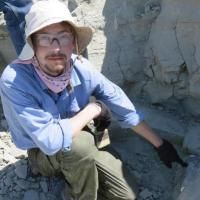First virtual endocasts of adapiform primates.
Date
2016-10
Journal Title
Journal ISSN
Volume Title
Repository Usage Stats
views
downloads
Citation Stats
Attention Stats
Abstract
Well-preserved crania of notharctine adapiforms from the Eocene of North America provide the best direct evidence available for inferring neuroanatomy and encephalization in early euprimates (crown primates). Virtual endocasts of the notharctines Notharctus tenebrosus (n = 3) and Smilodectes gracilis (n = 4) from the middle Eocene Bridger formation of Wyoming, and the late Eocene European adapid adapiform Adapis parisiensis (n = 1), were reconstructed from high-resolution X-ray computed tomography (CT) data. While the three species share many neuroanatomical similarities differentiating them from plesiadapiforms (stem primates) and extant euprimates, our sample of N. tenebrosus displays more variation than that of S. gracilis, possibly related to differences in the patterns of cranial sexual dimorphism or within-lineage evolution. Body masses predicted from associated teeth suggest that N. tenebrosus was larger and had a lower encephalization quotient (EQ) than S. gracilis, despite their close relationship and similar inferred ecologies. Meanwhile, body masses predicted from cranial length of the same specimens suggest that the two species were more similar, with overlapping body mass and EQ, although S. gracilis exhibits a range of EQs shifted upwards relative to that of N. tenebrosus. While associated data from other parts of the skeleton are mostly lacking for specimens included in this study, measurements for unassociated postcrania attributed to these species yield body mass and EQ estimates that are also more similar to each other than those based on teeth. Regardless of the body mass prediction method used, results suggest that the average EQ of adapiforms was similar to that of plesiadapiforms, only overlapped the lower quadrant for the range of extant strepsirrhines, and did not overlap with the range of extant haplorhines. However, structural changes evident in these endocasts suggest that early euprimates relied more on vision than olfaction relative to plesiadapiforms, despite having relatively small endocranial volumes compared to extant taxa.
Type
Department
Description
Provenance
Subjects
Citation
Permalink
Published Version (Please cite this version)
Publication Info
Harrington, Arianna R, Mary T Silcox, Gabriel S Yapuncich, Doug M Boyer and Jonathan I Bloch (2016). First virtual endocasts of adapiform primates. Journal of human evolution, 99. pp. 52–78. 10.1016/j.jhevol.2016.06.005 Retrieved from https://hdl.handle.net/10161/18079.
This is constructed from limited available data and may be imprecise. To cite this article, please review & use the official citation provided by the journal.
Collections
Scholars@Duke

Gabriel Yapuncich
I hail from the great mountain states of Montana (the state of my birth) and Wyoming (the state of my childhood). I have a bachelor's degree in English literature from the University of Wisconsin and a bachelor's degree in the evolutionary biology from Columbia University. I completed my PhD in evolutionary anthropology at Duke University in March 2017, working with Dr. Doug M. Boyer. I have taught gross and microanatomy to Duke University School of Medicine students since 2018. In 2021, I joined the DUSOM MD program as an Assistant Professor of the Practice of Medical Education and Director of Accreditation and Continuous Quality Improvement.

Douglas Martin Boyer
Unless otherwise indicated, scholarly articles published by Duke faculty members are made available here with a CC-BY-NC (Creative Commons Attribution Non-Commercial) license, as enabled by the Duke Open Access Policy. If you wish to use the materials in ways not already permitted under CC-BY-NC, please consult the copyright owner. Other materials are made available here through the author’s grant of a non-exclusive license to make their work openly accessible.
